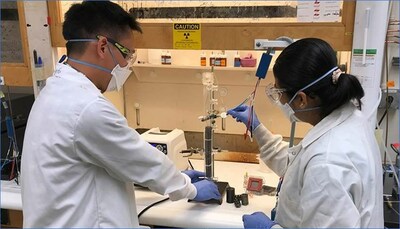This innovative technology could help revolutionize biomethane production and help decarbonize gas infrastructure by displacing traditional natural gas with carbon-neutral synthetic biomethane.
LOS ANGELES, March 19, 2024 /PRNewswire/ -- Southern California Gas Company (SoCalGas) today announced its collaboration with Electrochaea and Lawrence Livermore National Laboratory (LLNL) on an innovative research project that aims to develop a single-stage electro-bioreactor to transform excess renewable electricity and biogas into carbon-neutral synthetic biomethane, also known as renewable natural gas (RNG). This approach could mark a significant advancement in power to gas technology and underscores the viability of potential for synthetic biomethane to help decarbonize natural gas infrastructure and its end uses from residential heating to manufacturing industries and transportation. SoCalGas has contributed to the project's technical development and helped provide funding, which was also supported by a $1 million grant from the Department of Energy (DOE).
"This technology is not just an innovative approach to energy generation; it has the potential to be a versatile solution that aligns with California's vision for carbon neutrality by 2045," said Jawaad Malik, Chief Strategy and Sustainability Officer at SoCalGas. "This project demonstrates our aspirations for a sustainable energy future and highlights how strategic collaborations can yield solutions designed to benefit the environment, the economy and our communities."
If developed at scale, this technology could increase the yield of RNG produced from carbon dioxide sources like anaerobic digesters, landfills, dairies, fermentation facilities or industrial processes. The hybrid bioreactor and electrolyzer system harnesses the power of Electrochaea's proprietary microbial biocatalyst, which consumes hydrogen and carbon dioxide, transforming these inputs into RNG.
"We believe this technology will help enable decarbonization of the natural gas grid infrastructure by providing a renewable source of natural gas," said Simon Pang, a materials scientist in LLNL's Materials Science Division who heads the project. "This renewable natural gas can be moved and used in existing infrastructure, allowing the technology to be deployed soon to meet green energy demand. Moreover, by producing pipeline-quality renewable natural gas from biogas, we can increase the value of biogas and reduce the likelihood that it will be vented to the atmosphere, reducing greenhouse gas emissions and improving local air quality."
The two-year project aims to efficiently combine the processes of electrolysis and methanation in one streamlined unit. A single unit would simplify how the system works, bring efficiency, lower costs, and have a potential to adjust to changing energy demand and renewable electricity sources.
"Electrochaea's team is highly committed to contributing to a safe, affordable, and environmentally friendly energy supply now and in the future. The new highly efficient single-stage bioreactor is an essential asset in this endeavor," said Dr. Doris Hafenbradl, Electrochaea's Chief Technology Officer and Managing Director. "We are excited to collaborate with SoCalGas and Lawrence Livermore National Laboratory who are undisputed leaders in their respective fields. The enthusiasm to continue and expand this collaborative effort is a testament to the shared commitment to making a meaningful impact on the energy landscape."
Cleaner energy innovations designed to help decarbonize hard-to-electrify sectors will be a key component of California's efforts to achieve carbon neutrality by 2045. To that end, SoCalGas continues to develop Angeles Link, a proposed clean renewable hydrogen pipeline system to serve Southern and Central California. Angeles Link could be the nation's largest clean renewable hydrogen pipeline system and help significantly reduce greenhouse gas emissions from heavy-duty transportation, electric generation, industrial processes and other hard-to-electrify sectors of the California economy.
Learn more about how SoCalGas is working to help achieve a future through innovation, collaboration and decarbonization at https://www.socalgas.com/sustainability
About SoCalGas
Headquartered in Los Angeles, SoCalGas is the largest gas distribution utility in the United States. SoCalGas aims to deliver affordable, reliable, and increasingly renewable gas service to approximately 21 million consumers across approximately 24,000 square miles of Central and Southern California. We believe gas delivered through our pipelines plays a key role in California's clean energy transition by supporting energy system reliability and resiliency and enabling integration of renewable resources.
SoCalGas' mission is to build the cleanest, safest and most innovative energy infrastructure company in America. In support of that mission, SoCalGas aspires to achieve net-zero greenhouse gas emissions in its operations and delivery of energy by 2045 and to replace 20 percent of its traditional natural gas supply to core customers with renewable natural gas (RNG) by 2030. RNG can be made from waste created by landfills and wastewater treatment plants. SoCalGas is also investing in its gas delivery infrastructure while working to keep bills affordable for customers. SoCalGas is a subsidiary of Sempra (NYSE: SRE), an energy infrastructure company based in San Diego.
For more information visit socalgas.com/newsroom or connect with SoCalGas on X (formerly Twitter) (@SoCalGas), Instagram (@SoCalGas) and Facebook.
This press release contains forward-looking statements within the meaning of the Private Securities Litigation Reform Act of 1995. Forward-looking statements are based on assumptions about the future, involve risks and uncertainties, and are not guarantees. Future results may differ materially from those expressed or implied in any forward-looking statement. These forward-looking statements represent our estimates and assumptions only as of the date of this press release. We assume no obligation to update or revise any forward-looking statement as a result of new information, future events or otherwise.
In this press release, forward-looking statements can be identified by words such as "believe," "expect," "intend," "anticipate," "contemplate," "plan," "estimate," "project," "forecast," "envision," "should," "could," "would," "will," "confident," "may," "can," "potential," "possible," "proposed," "in process," "construct," "develop," "opportunity," "preliminary," "initiative," "target," "outlook," "optimistic," "poised," "maintain," "continue," "progress," "advance," "goal," "aim," "commit," or similar expressions, or when we discuss our guidance, priorities, strategy, goals, vision, mission, opportunities, projections, intentions or expectations.
Factors, among others, that could cause actual results and events to differ materially from those expressed or implied in any forward-looking statement include: decisions, investigations, inquiries, regulations, denials or revocations of permits, consents, approvals or other authorizations, renewals of franchises, and other actions, including the failure to honor contracts and commitments, by the (i) California Public Utilities Commission (CPUC), U.S. Department of Energy, U.S. Internal Revenue Service and other regulatory bodies and (ii) U.S. and states, counties, cities and other jurisdictions therein where we do business; the success of business development efforts and construction projects, including risks related to (i) completing construction projects or other transactions on schedule and budget, (ii) realizing anticipated benefits from any of these efforts if completed, (iii) obtaining third-party consents and approvals, and (iv) third parties honoring their contracts and commitments; macroeconomic trends or other factors that could change our capital expenditure plans and their potential impact on rate base or other growth; litigation, arbitrations and other proceedings, and changes to laws and regulations, including those related to tax and trade policy; cybersecurity threats, including by state and state-sponsored actors, of ransomware or other attacks on our systems or the systems of third parties with which we conduct business, including the energy grid or other energy infrastructure; the availability, uses, sufficiency, and cost of capital resources and our ability to borrow money on favorable terms and meet our obligations, including due to (i) actions by credit rating agencies to downgrade our credit ratings or place those ratings on negative outlook, (ii) instability in the capital markets, or (iii) rising interest rates and inflation; the impact on affordability of our customer rates and our cost of capital and on our ability to pass through higher costs to customers due to (i) volatility in inflation, interest rates and commodity prices and (ii) the cost of meeting the demand for lower carbon and reliable energy in California; the impact of climate and sustainability policies, laws, rules, regulations, disclosures and trends, including actions to reduce or eliminate reliance on natural gas, increased uncertainty in the political or regulatory environment for California natural gas distribution companies, the risk of nonrecovery for stranded assets, and uncertainty related to relevant emerging and early-stage technologies; weather, natural disasters, pandemics, accidents, equipment failures, explosions, terrorism, information system outages or other events, such as work stoppages, that disrupt our operations, damage our facilities or systems, cause the release of harmful materials or fires or subject us to liability for damages, fines and penalties, some of which may not be recoverable through regulatory mechanisms or insurance or may impact our ability to obtain satisfactory levels of affordable insurance; the availability of natural gas and natural gas storage capacity, including disruptions caused by failures in the pipeline system or limitations on the withdrawal of natural gas from storage facilities; and other uncertainties, some of which are difficult to predict and beyond our control.
These risks and uncertainties are further discussed in the reports that the company has filed with the U.S. Securities and Exchange Commission (SEC). These reports are available through the EDGAR system free-of-charge on the SEC's website, www.sec.gov, and on Sempra's website, www.sempra.com. Investors should not rely unduly on any forward-looking statements.
Sempra Infrastructure, Sempra Infrastructure Partners, Sempra Texas, Sempra Texas Utilities, Oncor Electric Delivery Company LLC (Oncor) and Infraestructura Energética Nova, S.A.P.I. de C.V. (IEnova) are not the same companies as the California utilities, San Diego Gas & Electric Company or Southern California Gas Company, and Sempra Infrastructure, Sempra Infrastructure Partners, Sempra Texas, Sempra Texas Utilities, Oncor and IEnova are not regulated by the CPUC.
SOURCE Southern California Gas Company



